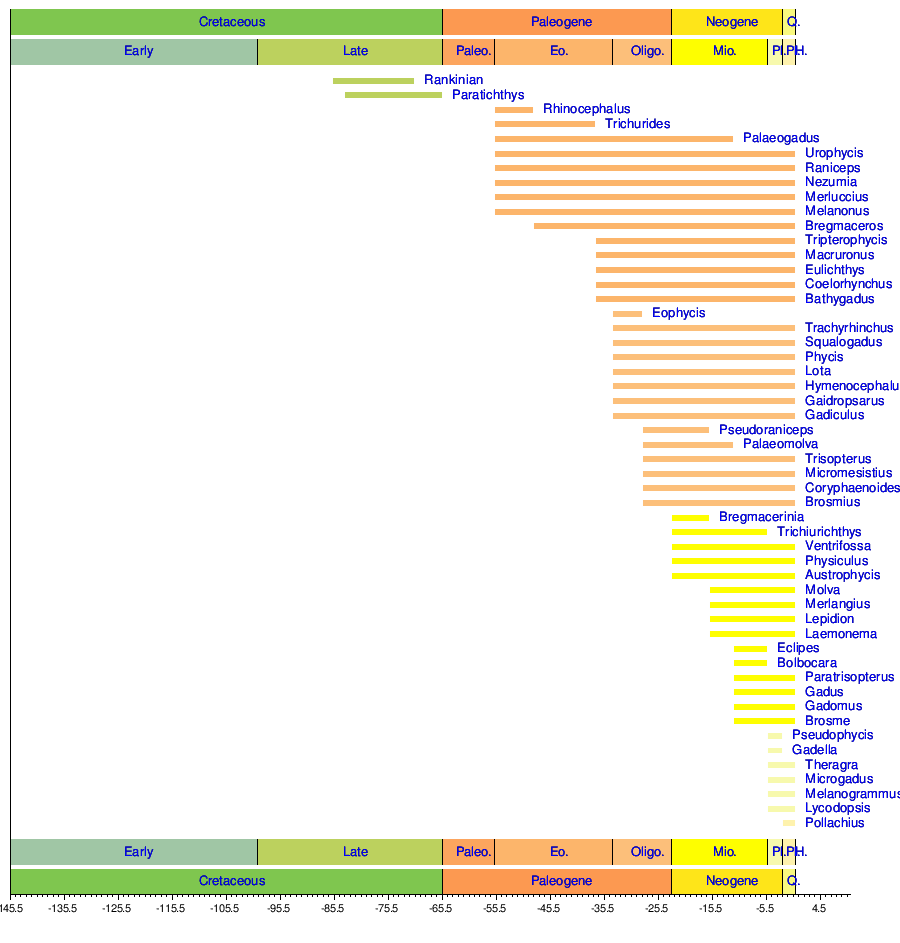| Gadiformes Temporal range: Maastrichtian–present PreꞒ Ꞓ O S D C P T J K Pg N | |
|---|---|

| |
| Gadus morhua | |
| Scientific classification | |
| Domain: | Eukaryota |
| Kingdom: | Animalia |
| Phylum: | Chordata |
| Class: | Actinopterygii |
| Superorder: | Paracanthopterygii |
| Order: | Gadiformes Goodrich, 1909 |
| Type species | |
| Gadus morhua Linnaeus 1758 | |
| Families | |
| |
Gadiformes /ˈɡædɪfɔːrmiːz/, also called the Anacanthini, are an order of ray-finned fish that include the cod, hakes, pollock, haddock, burbot, rocklings and moras, many of which are food fish of major commercial value. They are mostly marine fish found throughout the world and the vast majority are found in temperate or colder regions (tropical species are typically deep-water) while a few species may enter brackish estuaries. Pacific tomcods, one of the two species that makes up the genus Microgadus, are able to enter freshwater, but there is no evidence that they breed there. Some populations of landlocked Atlantic tomcod on the other hand, complete their entire life cycle in freshwater. Yet only one species, the burbot (Lota lota), is a true freshwater fish.
Common characteristics include the positioning of the pelvic fins (if present), below or in front of the pectoral fins. Gadiformes are physoclists, which means their swim bladders do not have a pneumatic duct. The fins are spineless. Gadiform fish range in size from the codlets, which may be as small as 7 cm (2.8 in) in adult length, to the Atlantic cod, Gadus morhua, which reaches up to 2 m (6.6 ft).
The earliest gadiforms are Palaeogadus weltoni from the Maastrichtian of the United States and the undescribed, informally named "Protocodus" from the Early Paleocene of Greenland.
Timeline of genera

References
- Iwamoto, T., Nakayama, N., Shao, K.-T. & Ho, H.-C. (2015): Synopsis of the Grenadier Fishes (Gadiformes; Teleostei) of Taiwan. Proceedings of the California Academy of Sciences, (Series 4), 62 (3): 31–126.
- The Freshwater Fishes of British Columbia
- Cohen, D.M. (1998). Paxton, J.R.; Eschmeyer, W.N. (eds.). Encyclopedia of Fishes. San Diego: Academic Press. pp. 130–132. ISBN 0-12-547665-5.
- Stringer, Gary; Schwarzhans, Werner (2021-09-01). "Upper Cretaceous teleostean otoliths from the Severn Formation (Maastrichtian) of Maryland, USA, with an unusual occurrence of Siluriformes and Beryciformes and the oldest Atlantic coast Gadiformes". Cretaceous Research. 125: 104867. Bibcode:2021CrRes.12504867S. doi:10.1016/j.cretres.2021.104867. ISSN 0195-6671.
- Friedman, Matt; V. Andrews, James; Saad, Hadeel; El-Sayed, Sanaa (2023-06-16). "The Cretaceous–Paleogene transition in spiny-rayed fishes: surveying "Patterson's Gap" in the acanthomorph skeletal record André Dumont medalist lecture 2018". Geologica Belgica. doi:10.20341/gb.2023.002. ISSN 1374-8505.
| Extant orders of Actinopterygii (ray-finned fish) | |||||||||||||||||||||||||||||||||||||||||||||||
|---|---|---|---|---|---|---|---|---|---|---|---|---|---|---|---|---|---|---|---|---|---|---|---|---|---|---|---|---|---|---|---|---|---|---|---|---|---|---|---|---|---|---|---|---|---|---|---|
| |||||||||||||||||||||||||||||||||||||||||||||||
| |||||||||||||||||||||||||||||||||||||||||||||||